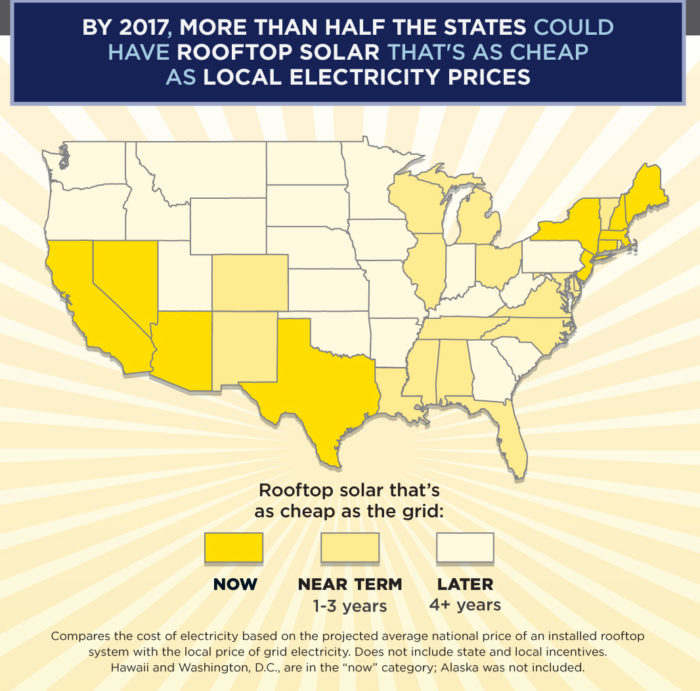
Image Credit: Union of Concerned Scientists
For people in 11 states and the District of Columbia, electricity produced by photovoltaic (PV) arrays costs no more than electricity purchased from a local utility, according to the Union of Concerned Scientists (UCS).
Mike Jacobs, the UCS’s senior energy analyst, writes in a blog posted August 20, that more than half the states in the country could reach what’s called “grid parity” by 2017.
The UCS started with two reports from the National Renewable Energy Laboratory: a conference paper presented at the 2012 World Renewable Energy Forum, and an earlier technical report. The UCS then produced its own update.
“What was really missing from these NREL studies is a projection of when the break-even point is likely to be reached,” Jacobs writes. “Not faulting the lab, just saying that when UCS compared the NREL numbers on break-even costs and other organizations’ projections of prices, this all became more clear. And much more interesting.”
Estimates are ‘conservative in some important ways’
The estimates take into account falling prices for solar panels and installation, and include the 30% federal investment tax credit, which is due to expire at the end of 2016, but no state or local incentives. State tax incentives are available in 45 states, and including them would lower the break-even cost, the UCS said.
For those and other reasons, the UCS said its estimates, as well as the NREL studies, were conservative in their outlook.
“Unlike most energy supply decisions, the choice of rooftop solar is within your control,” Jacobs writes. “If you want to adjust your economics to recognize carbon savings, you can do that too with this energy choice. There is so much that changes when solar becomes cost-effective. This is just getting started.”
In some regions, solar options limited
The UCS post paints a rosy picture for many homeowners, but a recent article in The Los Angeles Times suggests homeowners in some southeastern states, particularly Florida, have few opportunities to lease their systems, an increasingly popular path to solar-generated electricity.
“The business models that have made solar systems financially viable for millions of homeowners in California, New England and elsewhere around the country are largely illegal in Florida, Virginia, South Carolina and some other Southern states,” the newspaper says. “Companies that pioneered the industry, such as SolarCity Corp. and Sunrun Inc., do not even attempt to do business there.”
Companies like SolarCity install PV systems on a lease basis, allowing homeowners to buy electricity for rates lower than what utilities offer without the high upfront costs of buying their panels outright. That’s been a successful model in many parts of the country, but not in Florida.
Will Craven, a spokesman for SolarCity, told the paper that Florida is considered the “sleeping giant” of the industry. “It has a ton of sunshine, a ton of rooftops, but there is no rooftop solar industry in Florida.”
In South Carolina and Virginia, only a few hundred homes have PV systems, The Times said.
“In addition to the bans and restrictions on leasing arrangements, some Southern states assess taxes and fees on solar equipment that do not exist elsewhere,” the paper said.
In Florida, the difficulty of leasing PV pushed the owner of rental cottages to consider buying the panels. But the estimated cost is $106,000.
“My husband and I are looking at each other and saying, ‘This is absurd,'” Mary Wilkerson told the paper.
Weekly Newsletter
Get building science and energy efficiency advice, plus special offers, in your inbox.














One Comment
PV prices and leasing
These reports are SOOOOO behind the times. Here in Virginia, we're already BEYOND grid parity, with relatively cheap grid power and only the federal tax credit as an incentive. Through community bulk purchasing programs in some of the major Virginia markets (http://www.vasun.org/solarize-virginia/), residential installed prices are just north of $3/Watt....a far cry from the ~$5/Watt national average price shown for mid-2013 in the report's graph. Our local bulk buy program has attracted the interest of over 750 households (~1% of our local residential population) in just under two months....remains to be seen what the conversion rate is going to be.
Regarding solar leasing - it's a great idea for folks without capital and without access to low-interest credit. For just about everyone else, it's a no-brainer to own your own system. GTM Research predicts solar financing market share (though not total sales) will peak nationwide this year - http://www.greentechmedia.com/articles/read/Market-Share-for-Leasing-Residential-Solar-to-Peak-in-2014?utm_source=Solar&utm_medium=Picture&utm_campaign=GTMDaily
Log in or create an account to post a comment.
Sign up Log in